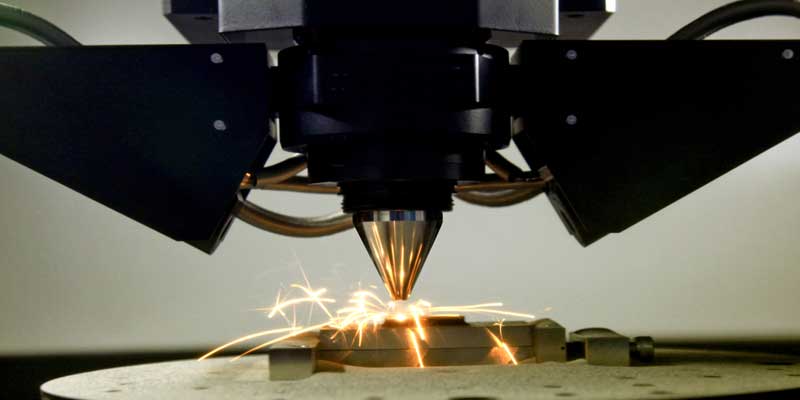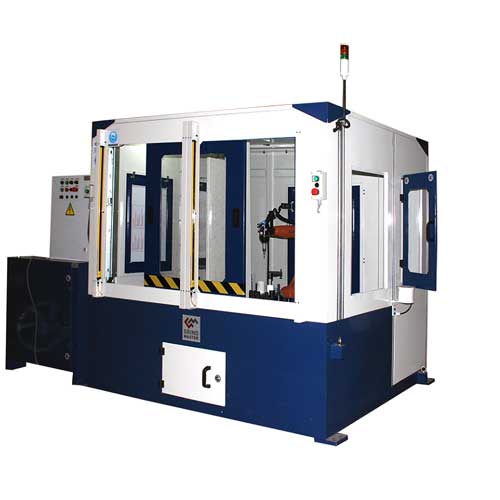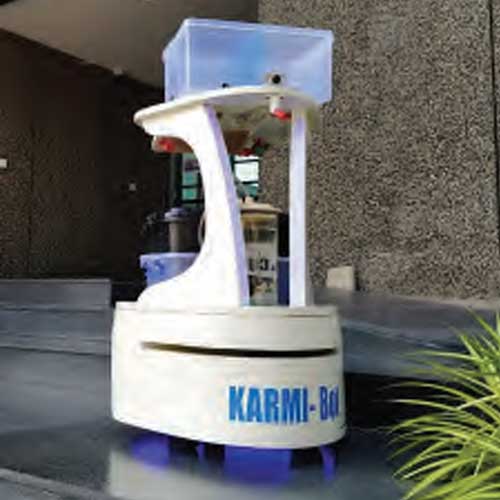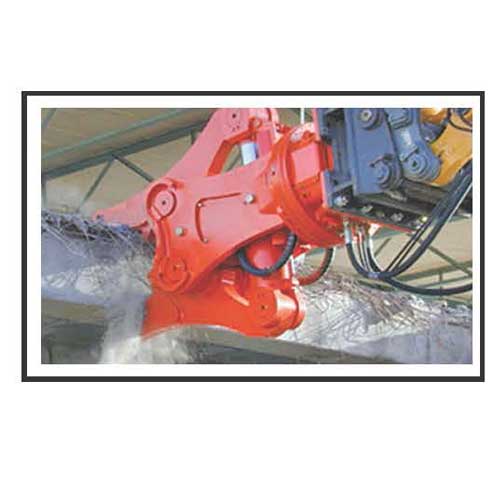Schedule a Call Back
COBOTS - new hope for industrial automation
 Interviews
Interviews- Jul 01,17

Automate almost anything’ proclaims Universal Robots (UR), a Danish manufacturer of smaller flexible industrial robot arms, based in Odense. With Industry 4.0 knocking at the doors of industrial world, Collaborative Robot—Cobot—is its mantra, and in their own words, “when we say the UR robot can automate virtually anything we mean virtually anything – from assembly to painting, from screw driving to labeling, from injection moulding to welding and from packaging to polishing.”
Only a year ago, UR established its Indian arm in Bengaluru. The company produces Cobots (collaborative robots) for a range of industries, textiles being one of them. Excerpts of a detailed interaction with Pradeep David, GM, Universal Robots (India and Sri Lanka)
When did UR enter India? Give us some background of the parent company and the Indian set-up since its inception.
The inception story of UR is incredibly interesting. In 2003, the three founders of the company—Esben Østergaard, Kasper Støy and Kristian Kassow—together came up with the idea of creating a light robot that is easy to install and programme as they could see that heavy, expensive and unwieldy robots where dominating robotics and there was a huge market for a more user-friendly option. In 2005, they officially founded UR with the aim of making robot technology accessible to small and medium-sized enterprises. An investment by Syddansk Innovation shaped the foundation of the company.
In 2008, the company sold its first product through distributors in Denmark and Germany. UR’s first product was the UR5, a six-jointed articulated arm robot that revolutionised the market for industrial robots. The UR5 weighs 18 kg, has a lifting capacity of up to 5 kg and a working radius of 85 cm. Within a year, the company expanded its business in the entire European markets. In 2011, UR entered the Asian market with a local office in China, and in next two years, UR established two subsidiaries, one in New York and the other one in Shanghai and also established a distributor network in South America and Oceania.
The second product UR 10 was also launched at the same time. It was targeted towards larger tasks with a lifting ability of 10 kg and a reach of 130 cm. In 2015, the company witnessed the launch of world’s most flexible, lightweight table-top robot UR3, to work alongside humans, which has the payload capacity of 3 kg and which can be used for light assembly tasks and automated workbench scenarios.
The company is a part of Teradyne Inc. and is headquartered in Odense, Denmark. UR has subsidiaries and regional offices in the USA, Spain, Germany, Italy, Czech Republic, China, Singapore, India, Japan, Taiwan and South Korea.
The Indian operation of UR started in 2016; though the customers in India started using UR cobots much before the launch of India office. UR has deployed over 200 Cobots since 2011, majorly in the market segments of automotive industry, FMCG, electronics, education and R&D centres. Bajaj Auto Ltd, which is our oldest customer in India, saw a gradual rise in the productivity and efficiency in their production after deploying UR cobots. It also increased the productivity of their employees along with their product quality. They have deployed over 100 cobots since 2010 and are now the third largest motorcycle manufacturer in the world.
Could you please give some details about the Cobot concept and also some details of the parent company’s experience globally?
A ‘cobot’ (collaborative robot) is a robot intended to physically interact with humans in a shared workspace, where the repetitive and heavy tasks are taken care by cobots and supervision and quality checks are done by human beings. It is a robotic arm designed to assist human beings in a specific task, as a guide or assistor and as a portable tool. Various researchers have proved that the teams made of humans and robots collaborating efficiently can be around 85 per cent more productive than teams made of either humans or robots. Cobots can safely work alongside humans, without any danger of injury, they are easy to deploy (just plug and play), flexible to use and inexpensive hence they are triggering the demand in the manufacturing industry comprehensively around the globe.
We, at UR, have the ‘first mover’ advantage and are the leading cobot manufacturers since the term was invented. More than 80 per cent of the UR cobots are in operation worldwide, working right next to humans with no safety guards to shield them. The safety system of our robots is approved and certified by TuV(The German Technical Inspection Association).
Since the first robot was launched in 2008, the company has experienced considerable growth with the user-friendly robots sold in more than 50 countries worldwide; 11,000 of our collaborative robots are in use worldwide for the industries like automotive and subcontractors, textiles and apparels, food and agriculture, furniture and equipment, electronics and technology, metal and machining, plastic and polymers, pharma and chemistry, scientific and research. Some of key customers on board with us globally are BMW, Volkswagen, Siemens, L’oreal, Bajaj Auto, Aurolabs, to name a few. UR, which has a strong distribution network all across the world, showed double-digit growth in its 2016 annual global result. UR cobots are also being used for some unusual, out-of-the-box applications like healthcare, physiotherapy, photography, cooking, bartending, farming, flying planes, etc. Developmental technologies like driverless autonomous vehicles could also see the use of cobots in the near future.
Which are the segments that show potential for robot applications?
We have experienced a huge demand in this sector especially in the Indian and Sri Lankan markets. Several Sri Lankan apparel companies have purchased cobots by UR to boost industrial productivity. We are also going to see vast deployments in India within a year. Cobots can be used in any segment of textile manufacturing where accuracy, precision and repetitive mass production is required. The key areas in textiles industry where UR cobots are being used are inspection, ‘pick and drop’, cutting and sewing. The world’s first robot, which has been used for sewing garments, is made by us. Many people are surprised to learn that a robot has been used to sew a piece of clothing.
Tell us something about the infrastructure and facilities built in India. How much of the products are indigenous, in the footsteps of Modi’s call for “Make in India”?
UR opened a regional office in Bengaluru in 2016 to provide better assistance to its Indian customers.The company is headquartered in Denmark and the R&D as well as the production work happens from only Denmark.
The Government’s emphasis on domestic manufacturing has encouraged the companies in India to use the best possible approach to increase their productivity and competency. Industrialists in our country want to maximise the ‘Make in India’ initiative by establishing manufacturing facilities of advanced quality. They also want to invest more in terms of automation and the latest equipment and technologies. As a result, we have seen enormous demand for our products in India because our cobots correspond exactly to the needs of companies and are being used to boost performance and add value in countless industries every day. Hence our goal is to assist and support companies in India to produce high-quality products and increase efficiency at an affordable cost. We believe in ‘Make in India’ with quality and our motive is to give power back to workers.
Cobots seem to be a prelude to Industry 4.0. How do you perceive this?
Cobots are a part of Industry 4.0 and we firmly consider that the evolution of the manufacturing industry now leads it to the next industrial revolution – Industry 5.0, which enables man and machine to work hand-in-hand. The scenario where humans and robots are inter-dependent and accomplish what each of them does best, safely. We are in an age where the application of next-generation automation is doing more than we ever thought possible, impacting individuals and businesses in many instances without even being noticed.
What are the memorable achievements in all these years -- that of the parent company and also the Indian outfit?
In 2015,UR was bought by the parent company Teradyne, the leading supplier of automated test equipment used to test semiconductors, wireless products, data storage, and complex electronic systems; it was a big milestone for us. In the same year Universal Robots was ranked No. 25 on MIT Technology Review’s list of the 50 Smartest Companies.
Our robots are now sold in more than 50 countries worldwide and 11,000 of our robots are deployed globally. Some of the leading manufacturers are using our technology around the globe such as BMW, Volkswagen, Siemens, L’Oreal, Bajaj Auto, Aurolabs etc. Our cobots have got over 65 patents pertaining to robot safety, robot construction, trajectory control, robot calibration and programming. We established office in Bengaluru in February 2016 but some of the companies in India are using our cobots from the past seven years, which is much before the launch of the local operations. One of them is Bajaj Auto, which has deployed over 120 cobots since 2011. We have been successful in developing a strong channel network, which covers the entire country from north to south and east to west.
If Cobots and robots are the future, what is the future of a country like India, where cheap labour rules some industries? According to a study done by International Federation of Robotics (2017); the future will be robots and humans working together. Robots substitute labour activities but do not replace jobs. Less than 10 per cent of jobs are fully automatable. Increasingly, robots are used to complement and augment labour activities; the net impact on jobs and the quality of work is positive. Automation provides the opportunity for humans to focus on higher-skilled, higher-quality and higher-paid tasks.
This clearly establishes the fact that the future of automation is not machines taking over human job but it’s the synchronisation of robots and human which lays the foundation of the future. We cannot always depend on labour for high quality and repetitive jobs because after a certain point they can get tired which can affect their performance whereas a robot can perform such work 24x7 hours, without a tea or lunch break. However there are certain quality checks and supervision roles which a human mind can do best as compared to a robot. The human robot collaboration ensures that the high precision, repetitive and heavy lifting jobs are taken care by UR cobots so that the labour can concentrate on high skilled and higher remuneration jobs. Hence it’s not the question of cheap labour any more it’s the question of quality, efficiency and higher productivity which can only be achieved through human robot collaboration.
Credit: Samuel Joseph, Editor, Indian Textile Journal.
Related Stories

The 3D metal revolution
India is rapidly emerging as a frontrunner in the world of 3D metal printing, a technology that is reshaping the way industries approach manufacturing. From aerospace to automotive, healthcare to de..
Read more
BYD India to showcase globally acclaimed models at Bharat Mobility Expo 2025
Plans to display new models including internationally successful models and BYD’s India line-up. BYD’s participation in Bharat Mobility and the upcoming launches of the new models is a testament..
Read more
Renewable energy sector to generate 43 mn jobs in India by 2050: CMD, IREDA
While delivering the Visionary Talk hosted by the 39th Indian Engineering Congress at Kolkata on December 20, 2024, Pradip Kumar Das spoke about the critical need for talent to drive the renewable e..
Read moreRelated Products

Robotic Deflashing of Aluminium Casting
Grind Master Robotic Deflashing Machine is an advanced and most reliable machine for Aluminium components. Robotic deflashing is a revolutionary technology developed by Grind Master Machines Pvt Lt Read more

Karmi Bot
Asimov Robotics offers a wide range of Karmi Bot.

Ductbot Compact Robotic Inspection System
Robosoft Systems offers a wide range of compact DuctBot robotic inspection systems. Read more









